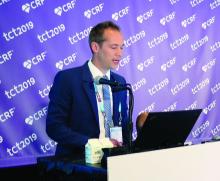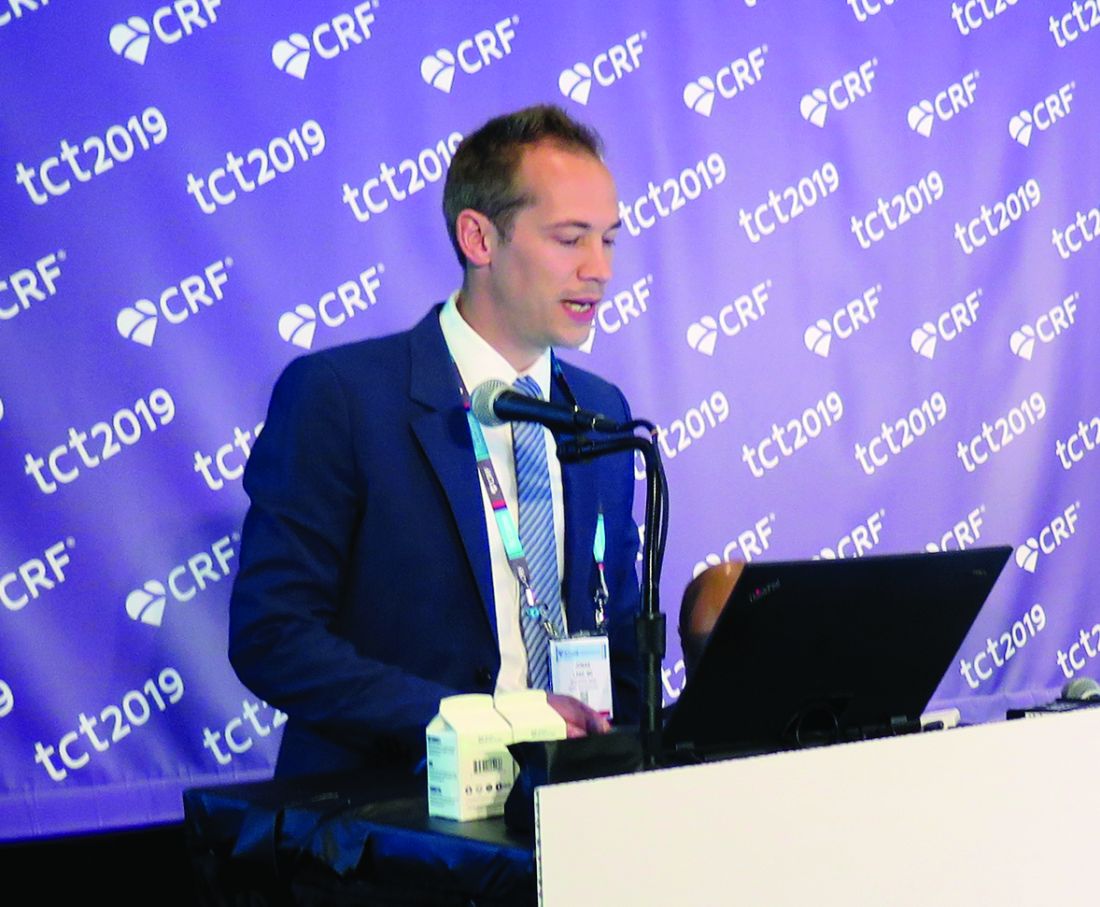User login
SAN FRANCISCO – The ACURATE neo transcatheter aortic valve replacement (TAVR) device failed to meet noninferiority, compared with the SAPIEN 3 device, in terms of the primary composite safety and efficacy endpoint at 30 days, a randomized, comparative trial showed.
“TAVR has become an indispensable treatment option for patients with symptomatic severe aortic stenosis across all risk categories,” Jonas Lanz, MD, MSc, said at the Transcatheter Cardiovascular Therapeutics annual meeting. “The generalizability of outcomes observed in landmark trials comparing TAVR with SAVR [surgical aortic valve replacement] to other commercial TAVR systems is limited by differences in device properties and lack of head-to-head device comparisons. Iterations of the SAPIEN balloon-expandable TAVR system have been extensively investigated in several large-scale, high-quality, randomized trials and registries setting the current benchmark in terms of safety and efficacy.”
The ACURATE neo is a novel self-expanding TAVR system associated with favorable outcomes in nonrandomized studies. It has been available in Europe since 2014 but has not gained Food and Drug Administration approval.
Between February 2017 and February 2019, in a randomized trial known as SCOPE I, Dr. Lanz and colleagues at 20 European sites enrolled 739 patients with severe, symptomatic aortic stenosis at increased surgical risk. Of these, 372 were assigned to transfemoral TAVR with the ACURATE neo and 367 were assigned to the SAPIEN 3 system. The researchers designed the study to investigate noninferiority of the primary endpoint, which was a composite of safety and efficacy derived from the Valve Academic Research Consortium–2 criteria and included all-cause death, any stroke, life-threatening or disabling bleeding, major vascular complications, coronary artery obstruction requiring intervention, acute kidney injury stage 2 or higher, valve-related dysfunction requiring repeat procedure, rehospitalization for valve-related symptoms or heart failure, moderate or severe prosthetic valve regurgitation, or prosthetic valve stenosis at 30 days.
Clinical follow-up information at 30 days was available for 99% and ECG follow-up for about 98% of the total study population. The mean age of the study participants was 82 years, 57% were female, their median STS Risk Score was 3.5, and their mean transvalvular aortic gradient was 42.2 mm Hg. Dr. Lanz, with the department of cardiology at Bern (Switzerland) University Hospital, reported that the primary endpoint rate in the intention-to-treat cohort for ACURATE neo was 23.7%, compared with 16.5% with SAPIEN 3, falling short of the threshold for noninferiority (P for noninferiority = 0.42).
“I think this speaks to the fact of how high the bar is right now – how good the procedure is [and] how good the devices are,” invited discussant Michael J. Mack, MD, a cardiac surgeon at Baylor Scott & White Health, Dallas, said during the media briefing. “It’s an incredibly high bar to meet for any new device.”
Certain single components of the primary endpoint were similar in the ACURATE neo group, compared with the SAPIEN 3 group, including all-cause death (2.5% vs. 0.8%, respectively) and stroke (1.9% vs. 3%), but acute kidney injury was more common in the ACURATE neo group (3% vs. 0.8%, as was paravalvular aortic regurgitation (9.4% vs. 2.8%). “The differences between the two TAVR devices were mainly driven by moderate or severe paravalvular regurgitation and stage 2 or 3 acute kidney injury in favor of the SAPIEN 3 device,” Dr. Lanz said at the meeting sponsored by the Cardiovascular Research Foundation. “An early composite safety and efficacy endpoint proved useful in discriminating the performance of different TAVR systems.”
He pointed out that a trial called SCOPE II is underway in Europe, with a new iteration of the ACURATE neo designed to reduce the risk of paravalvular leak.
The results of SCOPE I were published online at the time of presentation (Lancet. 2019 Sep 27. doi: 10.1016/S0140-6736[19]32220-2). SCOPE I was an investigator-initiated and -conducted study funded by a dedicated research grant from Symetis in Ecublens, Switzerland (part of Boston Scientific). Dr. Lanz had no relevant disclosures.
SAN FRANCISCO – The ACURATE neo transcatheter aortic valve replacement (TAVR) device failed to meet noninferiority, compared with the SAPIEN 3 device, in terms of the primary composite safety and efficacy endpoint at 30 days, a randomized, comparative trial showed.
“TAVR has become an indispensable treatment option for patients with symptomatic severe aortic stenosis across all risk categories,” Jonas Lanz, MD, MSc, said at the Transcatheter Cardiovascular Therapeutics annual meeting. “The generalizability of outcomes observed in landmark trials comparing TAVR with SAVR [surgical aortic valve replacement] to other commercial TAVR systems is limited by differences in device properties and lack of head-to-head device comparisons. Iterations of the SAPIEN balloon-expandable TAVR system have been extensively investigated in several large-scale, high-quality, randomized trials and registries setting the current benchmark in terms of safety and efficacy.”
The ACURATE neo is a novel self-expanding TAVR system associated with favorable outcomes in nonrandomized studies. It has been available in Europe since 2014 but has not gained Food and Drug Administration approval.
Between February 2017 and February 2019, in a randomized trial known as SCOPE I, Dr. Lanz and colleagues at 20 European sites enrolled 739 patients with severe, symptomatic aortic stenosis at increased surgical risk. Of these, 372 were assigned to transfemoral TAVR with the ACURATE neo and 367 were assigned to the SAPIEN 3 system. The researchers designed the study to investigate noninferiority of the primary endpoint, which was a composite of safety and efficacy derived from the Valve Academic Research Consortium–2 criteria and included all-cause death, any stroke, life-threatening or disabling bleeding, major vascular complications, coronary artery obstruction requiring intervention, acute kidney injury stage 2 or higher, valve-related dysfunction requiring repeat procedure, rehospitalization for valve-related symptoms or heart failure, moderate or severe prosthetic valve regurgitation, or prosthetic valve stenosis at 30 days.
Clinical follow-up information at 30 days was available for 99% and ECG follow-up for about 98% of the total study population. The mean age of the study participants was 82 years, 57% were female, their median STS Risk Score was 3.5, and their mean transvalvular aortic gradient was 42.2 mm Hg. Dr. Lanz, with the department of cardiology at Bern (Switzerland) University Hospital, reported that the primary endpoint rate in the intention-to-treat cohort for ACURATE neo was 23.7%, compared with 16.5% with SAPIEN 3, falling short of the threshold for noninferiority (P for noninferiority = 0.42).
“I think this speaks to the fact of how high the bar is right now – how good the procedure is [and] how good the devices are,” invited discussant Michael J. Mack, MD, a cardiac surgeon at Baylor Scott & White Health, Dallas, said during the media briefing. “It’s an incredibly high bar to meet for any new device.”
Certain single components of the primary endpoint were similar in the ACURATE neo group, compared with the SAPIEN 3 group, including all-cause death (2.5% vs. 0.8%, respectively) and stroke (1.9% vs. 3%), but acute kidney injury was more common in the ACURATE neo group (3% vs. 0.8%, as was paravalvular aortic regurgitation (9.4% vs. 2.8%). “The differences between the two TAVR devices were mainly driven by moderate or severe paravalvular regurgitation and stage 2 or 3 acute kidney injury in favor of the SAPIEN 3 device,” Dr. Lanz said at the meeting sponsored by the Cardiovascular Research Foundation. “An early composite safety and efficacy endpoint proved useful in discriminating the performance of different TAVR systems.”
He pointed out that a trial called SCOPE II is underway in Europe, with a new iteration of the ACURATE neo designed to reduce the risk of paravalvular leak.
The results of SCOPE I were published online at the time of presentation (Lancet. 2019 Sep 27. doi: 10.1016/S0140-6736[19]32220-2). SCOPE I was an investigator-initiated and -conducted study funded by a dedicated research grant from Symetis in Ecublens, Switzerland (part of Boston Scientific). Dr. Lanz had no relevant disclosures.
SAN FRANCISCO – The ACURATE neo transcatheter aortic valve replacement (TAVR) device failed to meet noninferiority, compared with the SAPIEN 3 device, in terms of the primary composite safety and efficacy endpoint at 30 days, a randomized, comparative trial showed.
“TAVR has become an indispensable treatment option for patients with symptomatic severe aortic stenosis across all risk categories,” Jonas Lanz, MD, MSc, said at the Transcatheter Cardiovascular Therapeutics annual meeting. “The generalizability of outcomes observed in landmark trials comparing TAVR with SAVR [surgical aortic valve replacement] to other commercial TAVR systems is limited by differences in device properties and lack of head-to-head device comparisons. Iterations of the SAPIEN balloon-expandable TAVR system have been extensively investigated in several large-scale, high-quality, randomized trials and registries setting the current benchmark in terms of safety and efficacy.”
The ACURATE neo is a novel self-expanding TAVR system associated with favorable outcomes in nonrandomized studies. It has been available in Europe since 2014 but has not gained Food and Drug Administration approval.
Between February 2017 and February 2019, in a randomized trial known as SCOPE I, Dr. Lanz and colleagues at 20 European sites enrolled 739 patients with severe, symptomatic aortic stenosis at increased surgical risk. Of these, 372 were assigned to transfemoral TAVR with the ACURATE neo and 367 were assigned to the SAPIEN 3 system. The researchers designed the study to investigate noninferiority of the primary endpoint, which was a composite of safety and efficacy derived from the Valve Academic Research Consortium–2 criteria and included all-cause death, any stroke, life-threatening or disabling bleeding, major vascular complications, coronary artery obstruction requiring intervention, acute kidney injury stage 2 or higher, valve-related dysfunction requiring repeat procedure, rehospitalization for valve-related symptoms or heart failure, moderate or severe prosthetic valve regurgitation, or prosthetic valve stenosis at 30 days.
Clinical follow-up information at 30 days was available for 99% and ECG follow-up for about 98% of the total study population. The mean age of the study participants was 82 years, 57% were female, their median STS Risk Score was 3.5, and their mean transvalvular aortic gradient was 42.2 mm Hg. Dr. Lanz, with the department of cardiology at Bern (Switzerland) University Hospital, reported that the primary endpoint rate in the intention-to-treat cohort for ACURATE neo was 23.7%, compared with 16.5% with SAPIEN 3, falling short of the threshold for noninferiority (P for noninferiority = 0.42).
“I think this speaks to the fact of how high the bar is right now – how good the procedure is [and] how good the devices are,” invited discussant Michael J. Mack, MD, a cardiac surgeon at Baylor Scott & White Health, Dallas, said during the media briefing. “It’s an incredibly high bar to meet for any new device.”
Certain single components of the primary endpoint were similar in the ACURATE neo group, compared with the SAPIEN 3 group, including all-cause death (2.5% vs. 0.8%, respectively) and stroke (1.9% vs. 3%), but acute kidney injury was more common in the ACURATE neo group (3% vs. 0.8%, as was paravalvular aortic regurgitation (9.4% vs. 2.8%). “The differences between the two TAVR devices were mainly driven by moderate or severe paravalvular regurgitation and stage 2 or 3 acute kidney injury in favor of the SAPIEN 3 device,” Dr. Lanz said at the meeting sponsored by the Cardiovascular Research Foundation. “An early composite safety and efficacy endpoint proved useful in discriminating the performance of different TAVR systems.”
He pointed out that a trial called SCOPE II is underway in Europe, with a new iteration of the ACURATE neo designed to reduce the risk of paravalvular leak.
The results of SCOPE I were published online at the time of presentation (Lancet. 2019 Sep 27. doi: 10.1016/S0140-6736[19]32220-2). SCOPE I was an investigator-initiated and -conducted study funded by a dedicated research grant from Symetis in Ecublens, Switzerland (part of Boston Scientific). Dr. Lanz had no relevant disclosures.
REPORTING FROM TCT 2019

